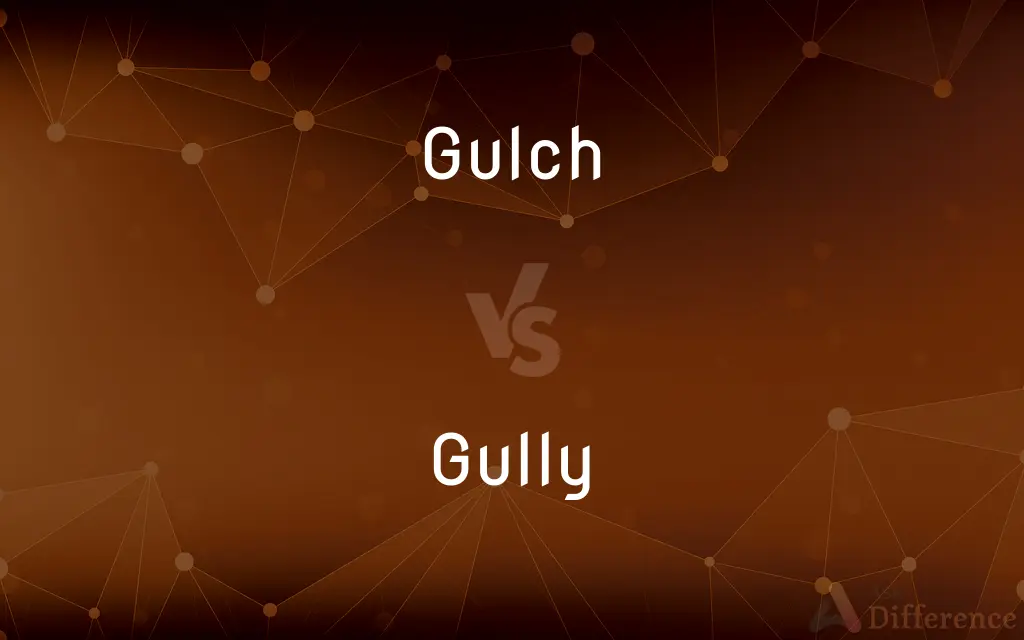Gulch vs. Gully — What's the Difference?
By Tayyaba Rehman & Urooj Arif — Updated on April 9, 2024
A gulch is a deep, V-shaped valley formed by erosion, typically dry except during rainstorms, while a gully is a smaller, narrower erosion feature caused by running water.

Difference Between Gulch and Gully
Table of Contents
ADVERTISEMENT
Key Differences
A gulch is characterized by its steep sides, often found in arid or semi-arid regions, and formed through the process of erosion. It is larger and deeper than a gully, making it a significant geographical feature that can influence the landscape. Whereas a gully is a smaller erosion feature, typically narrower and not as deep as a gulch, formed by the concentrated flow of water and often found on hillsides or within agricultural lands where water runoff is common.
The formation of a gulch occurs over a longer period, through the persistent action of water erosion in areas where water flow is not constant but occurs mainly during heavy rainfalls. This intermittent flow contributes to the deepening and widening of the gulch. On the other hand, a gully is formed more quickly due to the focused and continuous flow of water, especially in areas prone to heavy rains, leading to more immediate erosion of the soil.
Gulches are significant in shaping the terrain, especially in mountainous or rugged landscapes, where they contribute to the drainage and can form natural boundaries. In contrast, gullies, while they can be found in similar environments, are often more closely associated with human activities, such as agriculture, where they can become channels for water runoff and contribute to soil erosion if not managed properly.
In terms of ecological impact, gulches can provide unique habitats for a variety of plant and animal species, especially in arid regions where they may offer the only sources of water during dry periods. Gullies, however, are often seen as a problem in land management, as their formation can lead to the loss of topsoil and negatively affect agricultural productivity.
Both features highlight the power of water in shaping the earth’s surface, but their size, formation, and impact on the environment distinguish them from each other. A gulch, with its larger and more dramatic presence, plays a different role in the landscape compared to the smaller, but potentially more damaging, gully.
ADVERTISEMENT
Comparison Chart
Size and Depth
Larger and deeper, forming significant valleys.
Smaller and narrower, often less significant in depth.
Formation
Formed by erosion, typically in arid regions during rainstorms.
Formed by the concentrated flow of water, often quickly.
Location
Found in arid or semi-arid regions, mountainous areas.
Common on hillsides, agricultural lands.
Ecological Impact
Can provide unique habitats in arid regions.
Often associated with negative impacts like soil erosion.
Role in Landscape
Influences terrain, can form natural boundaries.
Affects land use, especially in agriculture.
Compare with Definitions
Gulch
Typically dry, except during heavy rain.
The gulch fills with water only after severe storms.
Gully
Narrower and shallower than a gulch.
The farmer worked to prevent erosion around the gully in the field.
Gulch
Influences the drainage and landscape.
The gulch served as a natural boundary for the two ecosystems.
Gully
Can be a concern for land management.
Landowners implemented measures to control the formation of gullies.
Gulch
A deep, V-shaped valley formed by erosion.
The hikers navigated the rocky terrain of the gulch.
Gully
Often results from and contributes to soil erosion.
The gully grew larger each year, threatening the nearby crops.
Gulch
Habitat for diverse species in dry areas.
The gulch was home to a variety of wildlife, seeking refuge in its depths.
Gully
Common in areas with heavy rainfall or runoff.
Gullies crisscrossed the landscape after the monsoon season.
Gulch
Found in arid or semi-arid regions.
The desert landscape was marked by several prominent gulches.
Gully
A small erosion feature caused by running water.
A gully formed on the hillside after the heavy rain.
Gulch
In xeric lands, a gulch is a deep V-shaped valley formed by erosion. It may contain a small stream or dry creek bed and is usually larger in size than a gully.
Gully
A gully is a landform created by running water, eroding sharply into soil or other relatively erodable material, typically on a hillside. Gullies resemble large ditches or small valleys, but are metres to tens of metres in depth and width.
Gulch
A narrow and steep-sided ravine marking the course of a fast stream.
Gully
A ravine formed by the action of water.
Gulch
A small ravine, especially one cut by a torrent.
Gully
A fielding position on the off side between point and the slips
He was caught in the gully by Jones
Gulch
(obsolete) To swallow greedily; to gulp down.
Gully
An alley.
Gulch
(obsolete) To fall heavily.
Gully
(of water) make gullies or deep channels in (land)
He began to pick his way over the gullied landscape
Gulch
A ravine-like or deep V-shaped valley, often eroded by flash floods; shallower than a canyon and deeper than a gully.
Gully
A deep ditch or channel cut in the earth by running water after a prolonged downpour.
Gulch
(obsolete) An act of gulching or gulping.
Gully
A channel in the side of a mountain, especially one forming a path for avalanches or rockfall.
Gulch
(obsolete) A glutton.
Gully
A large knife.
Gulch
Act of gulching or gulping.
Gully
To wear a deep ditch or channel in.
Gulch
A glutton.
Gully
To form a deep ditch or channel.
Gulch
A ravine, or part of the deep bed of a torrent when dry; a gully.
Gully
A trench, ravine or narrow channel which was worn by water flow, especially on a hillside.
Gulch
To swallow greedily; to gulp down.
Gully
A small valley.
Gulch
A narrow gorge with a stream running through it
Gully
(UK) A drop kerb.
Gully
A road drain.
Gully
(cricket) A fielding position on the off side about 30 degrees behind square, between the slips and point; a fielder in such a position
Gully
(UK) A grooved iron rail or tram plate.
Gully
A large knife.
Gully
(India) an alleyway or side street.
Gully
(obsolete) To flow noisily..
Gully
(transitive) To wear away into a gully or gullies.
Gully
A large knife.
Gully
A channel or hollow worn in the earth by a current of water; a short deep portion of a torrent's bed when dry.
Gully
A grooved iron rail or tram plate.
Gully
To wear into a gully or into gullies.
Gully
To flow noisily.
Gully
Deep ditch cut by running water (especially after a prolonged downpour)
Common Curiosities
Why are gullies a concern in agriculture?
Gullies can lead to significant soil erosion, reducing agricultural productivity and damaging land.
Can the formation of a gulch be prevented?
Preventing a gulch formation is challenging, as it involves managing erosion over large areas, often in natural settings.
How does a gully form?
A gully forms through the concentrated flow of water, leading to rapid erosion, often in areas with heavy rainfall or runoff.
How do gullies evolve over time?
Without intervention, gullies can grow larger, deepening and widening through continued erosion.
What differentiates a gulch from a canyon?
A gulch is typically narrower and less extensive than a canyon, which is a larger, more dramatic geological feature.
Are there any benefits to gullies?
While often seen negatively, gullies can sometimes enhance biodiversity by creating new habitats.
What measures can be taken to manage gully erosion?
Planting vegetation, building terraces, and creating diversion ditches are common methods to manage gully erosion.
What is a gulch?
A gulch is a deep, V-shaped valley primarily formed by the erosive power of water in arid or semi-arid regions.
What are the ecological impacts of gulches?
Gulches can provide unique habitats for plants and animals, especially in regions where water is scarce.
How are gulches and gullies similar?
Both are formed by the action of water erosion and can shape the landscape.
How can gullies affect water quality?
Gullies can contribute to sedimentation in water bodies, impacting water quality negatively.
Can human activities influence the formation of gulches?
While primarily natural features, human activities like deforestation can accelerate erosion, potentially leading to gulch formation.
Share Your Discovery

Previous Comparison
Important vs. Crucial
Next Comparison
Additional vs. ExtraAuthor Spotlight
Written by
Tayyaba RehmanTayyaba Rehman is a distinguished writer, currently serving as a primary contributor to askdifference.com. As a researcher in semantics and etymology, Tayyaba's passion for the complexity of languages and their distinctions has found a perfect home on the platform. Tayyaba delves into the intricacies of language, distinguishing between commonly confused words and phrases, thereby providing clarity for readers worldwide.
Co-written by
Urooj ArifUrooj is a skilled content writer at Ask Difference, known for her exceptional ability to simplify complex topics into engaging and informative content. With a passion for research and a flair for clear, concise writing, she consistently delivers articles that resonate with our diverse audience.
















































